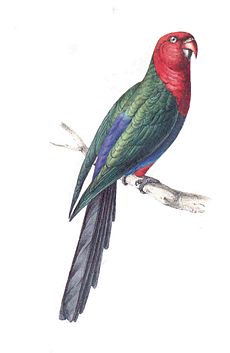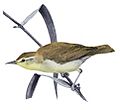William Swainson facts for kids
Quick facts for kids
William Swainson
|
|
|---|---|
 |
|
| Born | 8 October 1789 St Mary, Newington, London, England
|
| Died | 6 December 1855 (aged 66) Fern Grove, Hutt Valley, New Zealand
|
| Nationality | English |
| Citizenship | United Kingdom |
| Known for | Prolific illustrative works of natural history. Noted Quinarian. |
| Scientific career | |
| Fields | Ornithology, malacology, conchology, entomology, natural history |
| Notable students | Sir Walter Buller |
| Author abbrev. (botany) | Swainson |
| Notes | |
|
Emigrated to New Zealand in 1841
|
|
William Swainson FLS, FRS (8 October 1789 – 6 December 1855), was an English naturalist and artist. He is best known for his detailed illustrations and descriptions of birds and other animals and an illustrated classification of birds he produced.
Contents
Early life
Swainson was born on October 8, 1789, in London, England. He was the eldest son of John Timothy Swainson the Second (1756–1824). Both his grandfather and father held high posts in Her Majesty's Customs.
At the age of 14, William joined the Liverpool Customs as a junior clerk. He followed in his father's footsteps to become a fellow of the Linnean Society.
In 1815, Swainson returned from a trip to Italy in ill health and retired on half pay soon afterwards. He decided to dedicate his life to the study of natural history.
Career in natural history


In 1816, Swainson accompanied the English explorer Henry Koster to Brazil. He returned to England in 1818 with a collection of over 20,000 insects, 1,200 species of plants, drawings of 120 species of fish, and about 760 bird skins. Swainson then began publishing many illustrated works, mostly serially.
One of his most influential writings was the second volume of Fauna Boreali-Americana (1831), which he wrote with John Richardson. This series (1829–1837) was the first illustrated zoological study funded in part by the British government.
He also produced a second series of Zoological Illustrations (1832–33), three volumes of William Jardine's Naturalist's Library, and eleven volumes of Lardner's Cabinet Cyclopedia; he had signed a contract with the London publishers Longman to produce fourteen illustrated volumes of 300 pages in this series, one to be produced quarterly.
In 1839, Swainson bought land in Wellington, and gave up scientific literary work. He emigrated to New Zealand in 1841. The trip was not without incident, as the boat suffered damage en route and was in such a poor state that there was legal action on arrival. He purchased 1,100 acres (445 ha) in the Hutt Valley from the New Zealand Company, and established his estate of "Hawkshead". After a few months, this estate was claimed by a Māori chief, Taringakuri, which led to years of uncertainty and threat. He was an officer in a militia against in the Māoris in 1846. During these times he was largely dependent on his half pay.
Swainson was involved in property management and natural history-related publications from 1841 to 1855. In 1852, he took the post of Botanical Surveyor with the Victoria Government, after being invited by the Lieutenant-Governor Charles La Trobe to study local trees. He finished his report in 1853 in which he claimed a grand total of 1520 species and varieties of Eucalyptidae. He identified so many species of Casuarina that he ran out of names for them.
In 1854, Swainson returned to New Zealand to live at Fern Grove, [[Lower Hutt], where he died on 6 December 1855.
Personal life
Swainson married his first wife, Mary Parkes, in 1823. The couple had four sons (William John, George Frederick, Henry Gabriel and Edwin Newcombe) and a daughter (Mary Frederica). His wife Mary died in 1835.
Swainson remarried in 1840 to Ann Grasby. Two of their daughters were married in 1863: Edith Stanway Swainson married Arthur Halcombe, and Lucelle Frances Swainson married Richmond Beetham.
Interesting facts about William Swainson
- Swainson was also a talented artist, creating beautiful illustrations for his books. He drew many of the animals he studied himself.
- He became the first illustrator and naturalist to use lithography, which was a relatively cheap means of reproduction and did not require an engraver.
- Swainson was at times quite critical of the works of others and, later in life, others in turn became quite critical of him.
- He was elected a fellow of the Royal Society on 14 December 1820.
- Many birds retain a common name after Swainson, several of which were named by famous naturalists of the period.
- The genus Swainsona is named after his cousin Isaac Swainson (1746–1812).
- Swainson was the first Fellow of the Royal Society to move to New Zealand. He was later made an honorary Fellow of the Royal Society of Tasmania.
Eponymous taxa
Many species or subspecies retain his name, although many of his own species were later discredited or merged with others.
- John James Audubon named Swainson's warbler Limnothlypis swainsonii
- Charles Lucien Bonaparte named Swainson's hawk Buteo swainsoni
- Thomas Nuttall named Swainson's thrush Catharus ustulatus
- Swainson's francolin Francolinus swainsonii
- Swainson's sparrow Passer swainsonii
- Swainson's antcatcher Myrmeciza longipes
- Swainson's fire-eye Pyriglena atra
- Swainson's flycatcher Myiarchus swainsoni
- Swainson's toucan Ramphastos swainsonii
See also
 In Spanish: William John Swainson para niños
In Spanish: William John Swainson para niños






